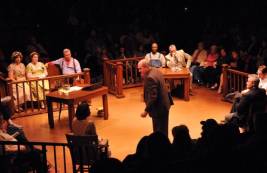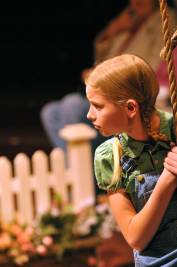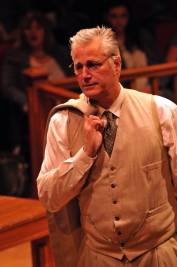
As I sat last night watching the lives of Atticus, Scout, Jem, and the rest of the characters created by Harper Lee in To Kill A Mockingbird, I couldn’t help looking at the audience around me, mostly seniors, their ages hovering around 76, give or take a few years, and think of the changes that have taken place in our society since 1935, the year Lee’s novel-turned-play takes place, the year in which many of those audience members first saw the light of day.
1935: Racial segregation codified by law in the South and de facto pretty much everywhere else. Interracial marriage illegal in half of the United States. A grand total of two African-Americans in congress. “All-Negro” shows or subservient roles the only ones available to black performers.
2011: Racial segregation prohibited by law throughout the U.S. No anti-miscegenation laws since 1967. An African American President who is himself the child of a mixed marriage. 43 black congressmen and women. As for African American performers, in the space of just the past month, this reviewer has raved about three leading ladies of color cast colorblind in romantic roles opposite Caucasian leading men.
Think of it! All of these changes—and more—during the lifetime of many if not most of those in attendance at Glendale Centre Theatre’s excellent revival of the Pulitzer Prize-winning To Kill A Mockingbird.
Lee’s semi-autobiographical novel centers on 10-year-old tomboy Jean Louise Finch, aka Scout, and her coming of age in small town Alabama during the Great Depression. It is through Scout’s eyes (as both the child she was and the adult she has become) that Lee is able to explore themes of racial injustice, social class, gender roles, courage, and compassion in what in lesser hands might have been just another young adult novel.
In episodic fashion, Lee shows us various snapshots of Scout’s life with older brother Jem, visiting childhood friend Dill (inspired by Lee’s real life friend Truman Capote), housekeeper Calpurnia, and above all her 50-year-old self-educated lawyer father Atticus Finch (played most memorably by Gregory Peck in the 1962 film adaptation). We also meet her neighbors, among them warmhearted Maudie Atkinson, crabby old Mrs. Dubose, and gossipy Stephanie Crawford. Little by little, Scout’s narrative introduces the plot thread around which the second half of the novel revolves—the rape trial of 25-year-old “Negro” Tom Robinson and his poor white trash accusers Mayella Ewell and her good-for-nothing father Bob. It is from this trial that narrator Scout reveals the racism so pervasive in post-Civil War South and discovers the heroism of her progressive-minded father, an upright man who saw beyond the hatred and ignorance surrounding them.
Fans of Lee’s novel and Horton Foote’s Oscar-winning screenplay may be disappointed by playwright Sergel’s decision to have it narrated by Miss Maudie, rather than through the eyes and voice of the woman Scout went on to become. (Interestingly, an earlier version of Sergel’s adaptation available at the L.A. Public Library features an adult Jean as narrator, leading this reviewer to wonder, “Why did the playwright feel the need for change?”) Also, Sergel’s Cliff Notes-style stage adaptation squeezes a dozen or more conversations and events into several days of a single summer—and about forty minutes stage time, cuts several memorable characters (especially Aunt Alexandra), and ends up focusing considerably more on the trial than Lee did in her novel.
Still, script quibbles aside, Glendale Centre Theatre’s revival, adeptly acted by a cast of seventeen and inventively directed by Diedra Celeste Miranda, conveys Harper Lee’s message of racial tolerance as forcefully as ever, particularly in the play’s gripping, suspenseful, emotionally wrenching second act.
With one or two exceptions, each actor plays but a single role, allowing each of Lee’s dozen and a half characters to acquire a life of his or her own. An in-the-round staging turns the audience into residents of the Finch family neighborhood and courtroom spectators during Tom Robinson’s sham trial. Celeste’s direction has many imaginative touches, like the tobacco Bob Ewell spits into a convenient spittoon before giving testimony and the deliberate, scornful shove he gives Atticus as he heads to take the stand.
An outstanding Thor Edgell brings warmth, strength, dignity, and valor to the role of Atticus, and manages all this with scarcely a hint of Gregory Peck in his performance, quite a feat given how thoroughly Peck’s work has become ingrained in moviegoers’ memories. Kate Landro is a marvelously folksy Maudie, appearing to have stepped right out of a 1935 flick. Camille Gibney, Liam Johnson, and Carter Thomas demonstrate precocity and promise in the roles of Scout, Jem, and Dill. Marianne Lewis fills Calpurnia with such inner dignity that one wishes Cal had the stage time Lee gives her in the novel. Lizanne Keigley’s memorable cameo as Mrs. Dubose gives hints of the excruciating physical pain the elderly meanie was doing her damnedest to hide. Kyle Kelley makes for a fine and folksy Heck Tate, Darryl Maximilian Robinson brings Reverend Sykes’ Baptist preacher-ness to dynamic life, and Richard Malmos’s performance as Judge Taylor provides subtle clues that indeed this is the wise, fair-minded man Lee describes in her novel. Deosick Burney shows us Tom Robinson’s grace, guts, and heart, while Craig Patton’s prosecuting attorney demonstrates how even a good man could fall prey to racism in the early 20th Century south. James Warnock is the embodiment of mean-and-nasty po’ white trash as Bob Ewell, and Devri Richmond makes for a pitiable, sniveling Mayella. In smaller roles, Heidi Appe is the gossipy Miss Stephanie Crawford and J. Allen Frame is a townsperson and the court clerk. Completing the cast, handsome leading man Nick Cimiluca vanishes into a pair of character roles, showing us the humanity of Walter Cunningham and, most particularly, the haunted soul of Boo Radley. I have seen several actors play Boo on stage. Cimiluca is the first to bring tears to my eyes.
Southern accents are a bit all over the place, some spot-on, others close to non-existent, and use of the N-word appears to have been somewhat softened from Sergel’s script, though it remains often enough to shock us with its ugliness.
Tim Dietlein’s clever set design gives us the facades of both the Finch and the Crawford homes, suggests Mrs. Dubose’s, and transforms effectively into the Act Two courthouse. (The first act tire-swing is a very nice touch.) Dietlein’s fine lighting succeeds in differentiating Miss Maudie’s narration from the play’s action, thereby making it seem less like she is breaking the fourth wall. Costume designer Angela Wood and Glendale Costumes have provided spot-on recreations of the 1930s South. Best of all is Andrew Villaverde’s sound design, the stage equivalent of a musical movie soundtrack, greatly upping emotions at appropriate moments. Paul Reid is stage manager.
Even today, over a half century since its publication, To Kill A Mockingbird remains one of the true classics of 20th Century American literature, possessing the rare quality of being accessible and relevant to readers as young as Scout and as old as Mrs. DuBose. As a history lesson, it shows us how bad things were and reminds us of the progress we have made and the work that still needs to be done. Though Sergel’s adaptation may not be all that we wish it were, Miranda and her cast make the most of it. If ever there was a Glendale Centre Theatre production that cries out to be seen by a younger-than-usual audience, To Kill A Mockingbird is that play. Memo to GCT seniors: Invite your children and their children see this production—a powerful reminder of the evils of inequality and a powerful lesson in courage and true morality.
Glendale Centre Theatre, 324 N. Orange St., Glendale.
www.glendalecentretheatre.com
–Steven Stanley
February 9, 2011





 Since 2007, Steven Stanley's StageSceneLA.com has spotlighted the best in Southern California theater via reviews, interviews, and its annual StageSceneLA Scenies.
Since 2007, Steven Stanley's StageSceneLA.com has spotlighted the best in Southern California theater via reviews, interviews, and its annual StageSceneLA Scenies.







 COPYRIGHT 2025 STEVEN STANLEY :: DESIGN BY
COPYRIGHT 2025 STEVEN STANLEY :: DESIGN BY